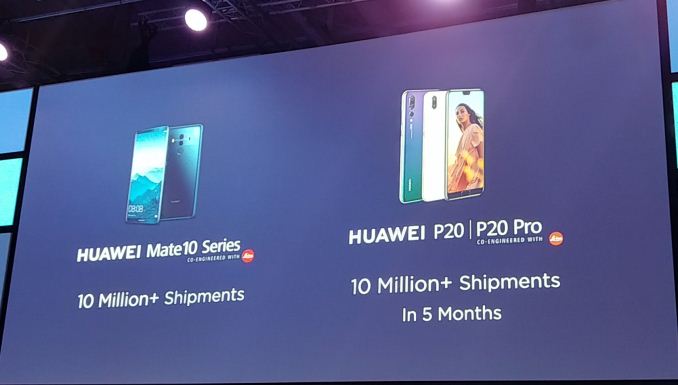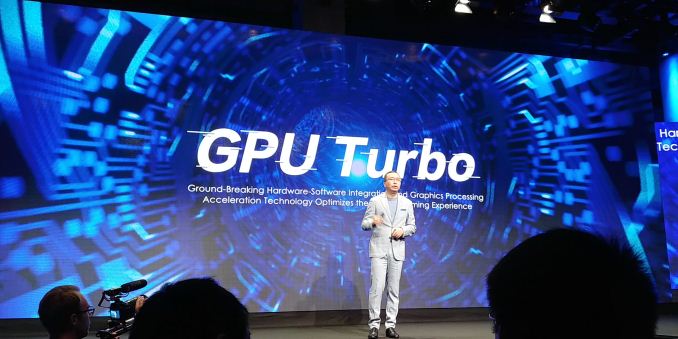Huawei’s GPU Turbo: Valid Technology with Overzealous Marketing
by Ian Cutress & Andrei Frumusanu on September 4, 2018 9:00 AM EST- Posted in
- Smartphones
- Huawei
- Mobile
- Benchmarks
- honor
- Neural Networks
- Kirin 970
- AI
Conclusion: Still A Plus, But
Back in 2015, AnandTech was in the extraordinary position to be the first western publication to actually meet with HiSilicon, reporting on the Kirin 950 from their Beijing media briefing. One of the things I still remember from back then was a definitive sense of humility and a very good sense of self-awareness in regards to the company’s products. Things have changed a lot in the past three years, and Huawei as a company has grown considerably since then.
Huawei and Honor combined now sell 153 million smartphones a year, and Huawei is now the second largest smartphone manufacturer worldwide, recently overtaking Apple. Honor claims it is fifth worldwide. Huawei has also stated that it will raise its future R&D budget from 15% of total revenue (US$13.23 billion) up to 20-30% during the race to 5G. Both are major players in this space, to the point where Huawei’s in-house silicon design team, HiSilicon, creates its own SoCs to help differentiate its products from those based on Qualcomm and MediaTek SoCs.
The explosive growth from Huawei not only goes into R&D, but also marketing. As the company has expanded, we have seen smartphone launch after smartphone launch held in glamorous places in Europe, along with perhaps the biggest sampling program for smartphone launches ever: all members of the invited press to the show, typically around 500-2000, are sampled. This is compared to Samsung and Apple who offer limited units to select press only, or LG who does both unit distribution at briefings (30+) and sampling to press. With the desire to gain brand awareness, and recognition, Huawei has gone into overdrive with its methodology, which has been a metaphorical double-edged sword – while delivering innovative solutions on the technical side, the brand message in some ways strayed from its more humble roots.
Developing technologies like GPU Turbo is going to be key for Huawei. Huawei has obvious gaming performance, image quality, and power efficiency deficits to Qualcomm’s Snapdragon. Playing with the silicon die for price/performance/area is a balancing act and will offer some gains, but typically at the expense of other specifications. This is why GPU Turbo is important: development of GPU Turbo is a "free" efficiency gain from a hardware perspective. Rather than involving new silicon, it's developed through a dedicated software effort, and as a result of the gains the feature is being rolled out across the range of smartphones that both Huawei and Honor offer at retail. GPU Turbo still has ways to go, such as expanding the number of games supported, and potential improvements on the horizon, such as having a single algorithm to cover all use-cases, but the future looks good for it.
Marketing these technologies, like GPU Turbo, is also important. Comparing the headline 60% better performance and 30% better efficiency data on the Kirin 970, with GPU Turbo, to the Kirin 960, without GPU Turbo, almost a year after the launch of the Kirin 970 and not declaring this in every presentation is a deliberate attempt at obfuscation. This is borne through Huawei’s own data in the same presentations, showing the Kirin 980 achieving minor performance and efficiency gains when the feature is enabled. The gains are still worth having, but are vastly lower than the numbers Huawei likes to promote every time GPU Turbo is mentioned.
This, along with the recent discovery of benchmark detection and acceleration to get higher scores, suggests that someone at Huawei is trying to pull the wool over the users’ eyes. It is not a good look, and despite Huawei’s explosive growth, key figures at the company are going to have to look inwards at how they want the company to be perceived on the main stage. The bigger the company is, the more it ends up under the microscope, so maintaining a level of honesty is important, otherwise the trust with the consumer is lost quick and fast. Trying to hide the real world numbers, just to get high on a performance table, just looks bad. It is bad.
The Final Word on GPU Turbo
As mentioned several times in the review, now that GPU Turbo has been explained in greater detail, the technology is genuine as far as we can tell, and is likely going to be a catalyst for a new way for vendors to differentiate themselves across the mobile spectrum, as the competition will be looking into similar solutions.
For everything we just stated about Huawei’s presentations, we hope that the company is giving plenty of kudos and praise to the teams that had the idea, and developed the technology. In an ever competitive landscape where SoC vendors need to differentiate and try to one-up each other, technologies like GPU Turbo are emerging as innovative advantages, improving the overall user experience.
Time, hardware, and software permitting, we will be aiming to go and get fully accurate benchmark data with and without GPU Turbo on the Kirin 980 after its launch. Stay tuned.
Benchmarking and Core Analysis by Andrei Frumusanu
Extra Analysis and Conclusion by Ian Cutress













64 Comments
View All Comments
eastcoast_pete - Tuesday, September 4, 2018 - link
Thanks Andrei! I agree that this is, in principle, an interesting way to adjust power use and GPU performance in a finer-grained way than otherwise implemented. IMO, it also seems to be an attempt to push HiSlilicon's AI core, as its other benefits are a bit more hidden for now (for lack of a better word). Today's power modes (at least on Android) are a bit all-high or all-low, so anything finer grained is welcome. Question: how long can the "turbo" turbo for before it gets a bit warm for the SoC? Did Huawei say anything about thermal limitations? I assume the AI is adjusting according to outside temperature and SoC to outside temperature differential?Regardless of AI-supported or not, I frequently wish I could more finely adjust power profiles for CPU, GPU and memory and make choices for my phone myself, along the lines of: 1. Strong, short CPU and GPU bursts enabled, otherwise balanced, to account for thermals and battery use (most everyday use, no gaming), 2. No burst, energy saver all round (need to watch my battery use) and 3. High power mode limited only by thermals (gaming mode), but allows to vary power allocations to CPU and GPU cores. An intelligent management and power allocation would be great for all these, but especially 3.
Ian Cutress - Tuesday, September 4, 2018 - link
GPU Turbo also has a CPU mode, if there isn't an NPU present. That's enabling Huawei to roll it out to older devices. The NPU does make it more efficient though.In your mode 3, battery life is still a concern. Pushing the power causes the efficiency to decrease as the hardware is pushed to the edge of its capabilities. The question is how much of a trade off is valid? Thermals can also ramp a lot too - you'll hit thermal skin temp limits a lot earlier than you think. That also comes down to efficiency and design.
kb9fcc - Tuesday, September 4, 2018 - link
Sounds reminiscent of the days when nVidia and ATI would cook some code into their drivers that could detect when certain games and/or benchmarking tools were being run and tweak the performance to return results that favored their GPU.mode_13h - Tuesday, September 4, 2018 - link
Who's to say Nvidia isn't already doing a variation of GPU Turbo, in their game-ready drivers? The upside is less, with a desktop GPU, but perhaps they could do things like preemptively spike the core clock speed and dip the memory clock, if they knew the next few frames would be shader-limited but with memory bandwidth to spare.Kvaern1 - Tuesday, September 4, 2018 - link
I don't suppose China has a law that punishes partyboss owned corporation for making wild dishonest claims.darckhart - Tuesday, September 4, 2018 - link
ehhh it's getting hype now, but I bet it will only be supported on a few games/apps. it's a bit like nvidia's game ready drivers: sure the newest big name game releases get support (but only for newer gpu) and then what happens when the game updates/patches? will the team keep the game in the library and let the AI keep testing so as to keep it optimized? how many games will be added to the library? how often? which SoC will continue to be supported?mode_13h - Tuesday, September 4, 2018 - link
Of course, if they just operated a cloud service that automatically trained models based on automatically-uploaded performance data, then it could easily scale to most apps on most phones.Ratman6161 - Tuesday, September 4, 2018 - link
meh....only for games? So what. Yes, I know a lot of people reading this article care about games, but for those of us who don't this is meaningless. But looking at it as a gamer might, it still seems pretty worthless. Per soc and per game? That's going to take constant updates to keep up with the latest releases. And how long can they keep that up? Personally if I were that interested in games, I'd just buy something that's better at gaming to begin with.mode_13h - Tuesday, September 4, 2018 - link
See my point above.Beyond that, the benefits of a scheme like this, even on "something that's better at gaming to begin with", is longer battery life and less heat. Didn't you see the part where it clocks everything just high enough to hit 60 fps? That's as fast as most phone's displays will update, so any more and you're wasting power.
mode_13h - Tuesday, September 4, 2018 - link
I would add that the biggest benefit is to be had by games, since they use the GPU more heavily than most other apps. They also have an upper limit on how fast they need to run.However, a variation on this could be used to manage the speeds of different CPU cores and the distribution of tasks between them.